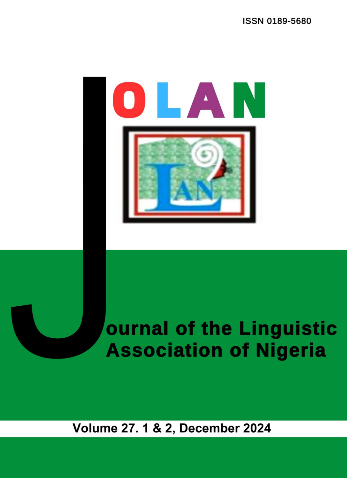A Study of Non-Verbal Communication in Yorùbá Novels: The Side Code
Abstract
Non-verbal communication is a very important aspect of communication which plays a very crucial role in interpersonal relationship. Its role in the accentuation of verbal communication cannot be overemphasized. Existing literature has not given enough attention to side code as a form of non-verbal communication in the Yorùba novel. This study fills the gap as it examines side code, the contexts in which it occurs in Yorùbá novels with a view to establishing its communicative value. The study adopts semiotic theories of Saussure and Charles Sanders Peirce. However, symbolic signification which is one of the major elements of semiotic serves as the major pillar on which this work rests. Four Yorùbá novels: Ìrìnkèrindò Nínú IgbóElégbè je and Ògbó jú Ọdẹ Nínú Igbó Irúnmo̩ lẹ̀ by D. O. Fagunwa, Ojú rí by Kola ́Oni and Saworoide ̣by Akinwumi Isola were purposively selected because ̣ they have elements of side code and were subjected to semiotic and textual analyses. Side code helps in cultural determinism in the codification of disaster, chaos, lopsidedness, disappointment, success, identification of status of personality and complementarity.
References
Adesanya, A. O. 2014. ‘Forms and Functions of Non-verbal Communication in Yorùbá Novels.’ Ph.D Thesis, University Of Ibadan, Ibadan, Nigeria.
Abímbọ́lá , W. 1977. Àwọn ojú odù mérẹ̀ẹ̀rìndínlógún. Ìbàdàn: Oxford University Press.
Ajíkòbí, O. 1985. ‘The Yorùbá concepts of right and left.” M.A. Project, Department of African languages and literatures, University of Lagos.
Barthes, R. 1967. Elements of semiology. London: Jonathan Cape Limited.
Chandler, D. 2006. Semiotics for beginners. http://www. aber.ac.uk/ media/documents/S4B retrieved 10th October, 2006.
Danesi, M. 2004. Messages, signs and meanings: a basic textbook in semiotics and communication. Toronto: Canadian Scholars’ Press Inc.
Eco, U. 1976. A theory of semiotics. London: Indiana University press.
Fágúnwà, D. 2005. Ìrìnkèrindò Nínú Igbó Elégbèje. Ìbàdàn: Nelson Publishers Ltd.
Fágúnwà, D. 2005a. Ògbójú Ọdẹ Nínú Igbó Irúnmo lẹ̀. Ìbàdàn: Nelson Publishers Ltd.
Fálétí, A. 1972. Baṣọ̀run Gáà. Ìbàdàn: Oníbọnòjé Press. Ilésanmí, T. M. 2004. Yorùbá orature and literature: a cultural analysis. Ilé-Ifẹ́:
Ọbáfẹ́mi Awólọ́wọ̀ University Press.
Ìs̩ ọ̀lá, A. 2008: Ṣaworoidẹ. Ìbàdàn: Univeristy Press Plc.
Johansen, J. D & Larsen, S.E. 2002. Signs in use: an introduction to semiotics. London and New York: Routledge.
Macdonald, M. 2009. Your body: the missing mannual. Sebastepol, CA: Pogue Press
Òní, K. 2001: Ojú rí. Ìbàdàn: Topdam Educational Publishers Nigeria Ltd. Peirce, C. 1931-58. Collected writings. 8 vols. (Eds.) Hartshorne, P. and Burks, A. Cambrdige, M.A: Harvard University Press.
Saussure, F. 1974. Course in general linguistics (Trans. Wade Baskin) London: Fontana: Colins
William, O., Archibald, J., Arnoff, M. & Rees-Miller, J. 2004 Contemporary linguistics: an introduction. UK: Bedford/Saint Martins.














